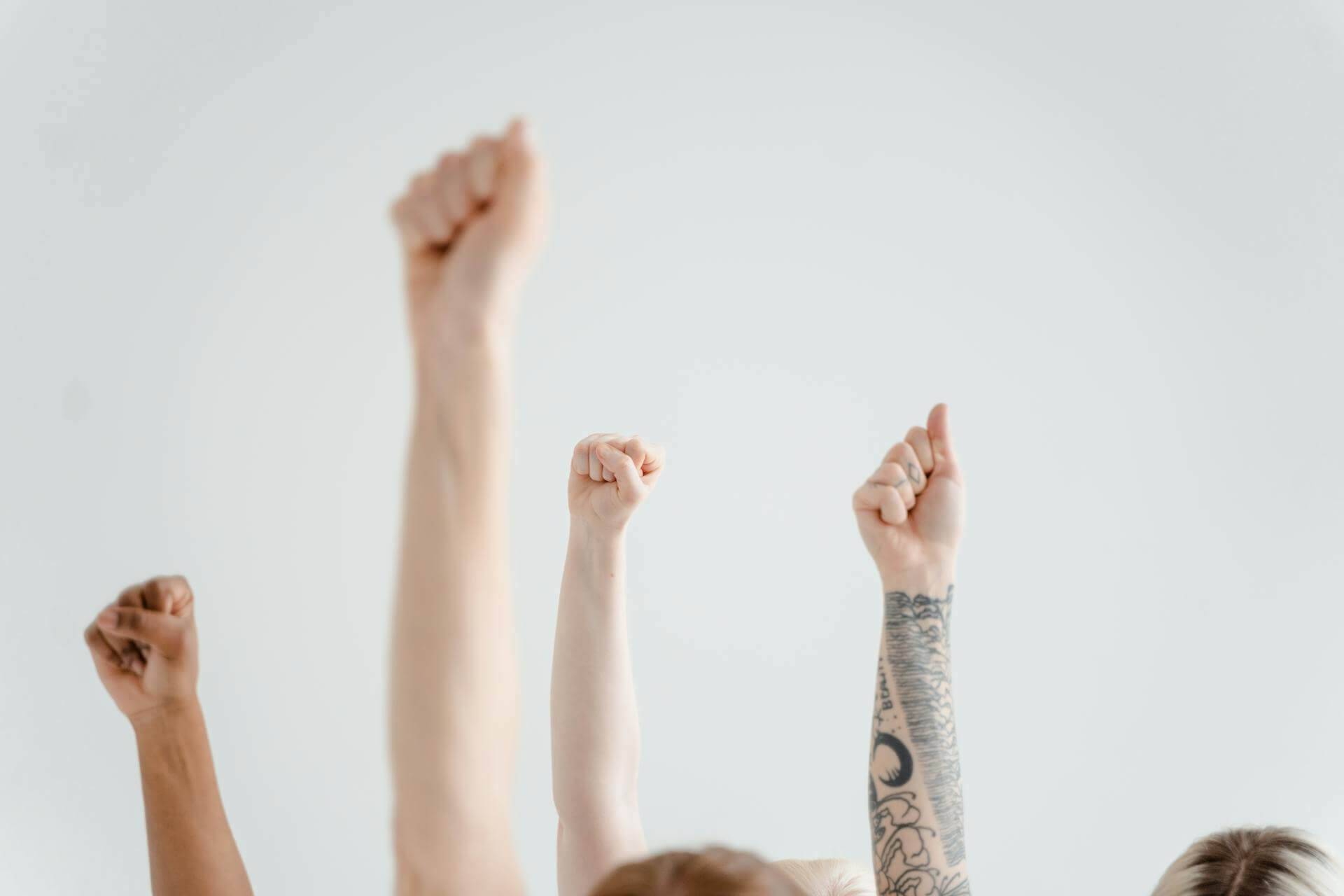
Practicing yoga in times of conflict
When I started practicing yoga, 5 years ago, I initially turned to it for my personal wellbeing. It was a way for me to reconnect with my body, find balance, heal, and regulate my nervous system. It also helped me with my physical and mental strength. Each practice became a moment of deep connection with myself, a safe space where I could shut out the noise of the outside world. I felt held and secure within the four walls of the studio.
As time went on, I began exploring the philosophy behind yoga more deeply. Asanas/movement is only a part of yoga, it became important for me to carry yogic principles beyond the mat and embody yoga in my daily life. In parallel, and in part thanks to my yoga journey, my awareness and understanding of the world around me had grown. I began feeling more connected to our collective existence, including our suffering. I understood what harms one, harms all. I remembered learning that the root of the word "yoga" is YUJ meaning union and started asking myself how this sense of unity extends from me to others.
As oppression and other social injustice intensified, I felt a growing sense of restlessness to act up. I began to ask myself: How can I use yoga to serve in times like these? Can yoga become my support tool in the midst of standing for justice?
At the same time, I felt a quiet fear rising within me; What if it becomes too much? What if engaging with this part of existence disrupts my own inner peace and balance? Something I have worked hard to attain. Again I found answers in Yoga, a tool to build resistance and mindful rest in order to stay engaged with the present, the world around me and my values.
This blog is an invitation to reflect: How do we stay rooted in the principles of peace and non-violence while also standing up for justice? How do we maintain our inner balance without turning away from the pain of others? And how can our practice support not just personal healing, but collective healing?

The yoga sutras
Within the philosophy of yoga, we find timeless teachings in the form of sutras, threads of wisdom passed down through generations.
I have reflected on some of the most important sutras, and to help us understand how deeply the sutras and yoga are connected to the work of justice and liberation.
Ahimsa – Non-Violence
Ahimsa, the principle of non-violence, is one of the core teachings of yoga philosophy. In Sanskrit, it means far more than simply refraining from physical harm, it calls us to minimize all forms of violence, including emotional, systemic, and structural.
Ahimsa was a guiding force in India’s struggle for independence and continues to be essential in any movement toward justice and liberation today. In my own practice, living Ahimsa helps me find the courage and strength within yoga to confront and disrupt violence.
To ignore injustice often feels, to me, like a subtle form of harm, one that tends to uphold the status quo. True non-violence is not passive; it invites us to respond not with apathy, but with compassion, clarity, and a deep commitment to change.
Satya – Truthfulness
Satya, teaches us to think, speak, and act with integrity. It is deeply linked to Ahimsa; our truths must not cause harm, but neither should the truth remain unspoken in the face of injustice.
Speaking your truth can feel uncomfortable at times. You may worry: If I speak up, I’ll offend someone. If I stay silent, I betray my values. Or you find it hard to decide what is exactly the truth? In those moments, pause. Ask yourself: Is what I’m about to say aligned with my values? Am I speaking from compassion? From integrity. As a reminder, I often tell myself if I feel like taking the easy path and staying “neutral”, “ neutrality is usually in benefit of the oppressor, of the bigger groups. To speak up, to express the truth is more important than we sometimes realise.”
Asteya – Non-Stealing
Asteya reminds us that to take more than we need from people, communities, or the Earth, is a form of violence. In a world built on systems of extraction and inequality, this Yama challenges us to examine where we benefit at the expense of others, and create ways to live with greater equity and integrity.
Aparigraha – Non-Attachment
Aparigraha teaches non-attachment. This was one important Yama that I had to remind myself of often. Sometimes fighting for justice often doesn’t yield immediate results. Just like we learn on the mat to be present in the process instead of being attached to the result, this sutra encourages us to stay committed without becoming consumed by what we cannot control. We do the work because it is right,not because we're promised a result.
Apart from that, I remind myself not to cling too tightly to personal peace or the comfort of avoiding injustice, especially when it comes at the expense of our shared humanity.
Brahmacharya – Right Use of Energy
Brahmacharya invites us to reflect on where our energy is being directed. To truly show up as our best selves and use our energy wisely, we must first listen to our bodies and honor what they need. Without enough inner nourishment and balance, it becomes difficult to fully embody and share the lessons we gain from our yoga practice.
On the mat, I started to use my practice to feel grounded and energized so that I can show up effectively in the world around me. I also kept reminding myself that It’s completely okay, and necessary at times, to direct my energy inward. I realised that this isn’t selfish; it’s an act of care that ultimately serves the collective.
Especially in times of conflict, it's easy to feel overwhelmed by the pain and chaos in the world. We can lose sight of the beauty and goodness that still remain. I find it important to find a balance here; redirecting my energy toward meaningful action, while also staying rooted in gratitude for the good in the world.
Yoga being about inner connection
In our yoga practice, we often focus on inner healing and to find the love within us. Love, as Martin Luther King Jr. once said, is “the only force, capable of transforming an enemy into a friend.” But love requires inner discipline, and inner connection. Practicing yoga is, at its core, for me training the heart and mind, to meet the world with calm and love and respond with strength and clarity
Focusing inward and being aware of the world around us are not opposing paths, they are deeply intertwined. As human beings, we are profoundly interconnected. We are, in yogic terms, all expressions of the same spirit: Brahman. And yet, this deep unity is not always reflected in our external realities. Inequality, violence, and systemic injustice create deep divisions. Our Yoga practice helps us become more one with ourself and when mindfully create more oneness in the world
Historically, yoga has not only been a path of personal liberation but also a tool for social transformation. Revolutionaries like Swami Vivekananda understood this well. During India’s nationalist movement under British occupation, he saw yoga as a means for awakening the body, mind, and spirit, not just for personal growth, but as preparation for collective emancipation.
Even the physical practice of asana as we know it today, Hatha Yoga, has roots in resistance. It evolved, in part, through the efforts of yogis in Bengal and North India during their struggle against British colonial rule. Yoga was a form of preparation, strengthening the body and mind for revolution and resilience.
(Source: Breathe Together Yoga – Yoga & Social Justice)
At its essence, yoga is the union, of body, mind, spirit, and the world we inhabit. The inner connection we build on the mat is not meant to detach us from reality but to prepare us to engage with it more mindfully. When we listen deeply within, we come to recognize our interdependence with others, our shared humanity, and our responsibility to each other. Once we’ve reconnected with our center, yoga calls us to extend that awareness outward: from self to service, from breath to action.
But what if the exposure of the violence is disrupting my inner peace?
The truth is, it will disrupt your peace at times. But that disruption doesn’t mean something is wrong with you, it means you're human, and you're feeling the weight of what’s happening in the world. It’s natural to want to protect your sense of peace, especially when you’ve worked hard to cultivate it.
But yoga teaches us that peace is not the same as comfort. True peace isn’t fragile. It doesn’t require us to turn away from suffering, it invites us to meet it with presence, compassion, and clarity. Still, we’re not meant to carry everything, all the time. There’s a difference between being aware and being consumed.
It’s okay if watching the news feels dysregulating. You don’t have to take in everything at once. It’s about recognizing your capacity and honoring it, while still staying connected to what’s happening in the world.
I’ve also realized that my anxiety didn’t always come from knowing too much. Sometimes, it came from not knowing where I fit into everything. In time, I discovered that informing myself, without overwhelming myself, and taking action actually helped me feel more grounded and empowered, not more overwhelmed.
We each have our own internal barometers, and they shift every day. That’s why I often come back to these questions:
- Am I grounded enough to witness this right now?
- What actions can I take, that
- What does balance look like for me?
- Can I engage without abandoning my own?
- What boundaries do I need to stay resourced, not depleted or overwhelmed?
How to Take Action (Ahimsa in Practice)
1. Reflect on Your Values
Start by looking inward. Take time to examine your beliefs, intentions, and how your actions align with this. Self-awareness is the foundation of meaningful action.
2. Host Fundraising Classes
Use your practice as a vehicle for change. Offer donation-based yoga classes to raise funds for grassroots organizations or causes rooted in peace, justice. These classes can be powerful spaces where intention and action meet.
3. Integrate Awareness into Class Practice
Navigating difficult local and global issues is a challenge for both students and teachers alike. It’s essential to face these realities head-on, while also recognizing and honoring the emotional heaviness they can bring. I was lucky to have a teacher who modeled this balance in her classes. She encouraged us to stay aware and informed without becoming overwhelmed. More importantly, she showed us how to calm our minds and bodies when feelings of sadness, anger, or lack of control by practising breathwork and yoga asanas.
Action Beyond the Studio
4. Participate in Peaceful Protests
Peaceful protest can be a form of sacred activism, a way of standing for justice with both strength and compassion. Showing up physically in support of human rights can make a difference.
5. Support Advocacy and Awareness
Sign petitions. Share trusted resources. Uplift the voices of those most affected. Support movements calling for ceasefires, human rights, and accountability. Every voice matters, and together, we shape not only public discourse, but also the collective understanding of what is acceptable, just, and possible


